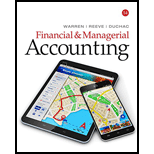
Financial & Managerial Accounting
14th Edition
ISBN: 9781337119207
Author: Carl Warren, James M. Reeve, Jonathan Duchac
Publisher: Cengage Learning
expand_more
expand_more
format_list_bulleted
Question
Chapter 23, Problem 23.20EX
(a)
To determine
Transfer price: The price charged for the goods and services transferred among the divisions is referred to as transfer price.
Approaches for setting transfer prices:
- Market price approach
- Negotiated price approach
- Cost price approach
To determine: The increase in Industries XP income from operations as a result of transfer pricing
(b)
To determine
The increase in I Division’s income from operations as a result of transfer pricing
(c)
To determine
The increase in C Division’s income from operations as a result of transfer pricing
(d)
To determine
The range of transfer price, if negotiated price approach is used.
Expert Solution & Answer
Want to see the full answer?
Check out a sample textbook solution
Students have asked these similar questions
Please explain this financial accounting problem by applying valid financial principles.
Can you solve this general accounting problem with appropriate steps and explanations?
I am looking for a reliable way to solve this financial accounting problem using accurate principles.
Chapter 23 Solutions
Financial & Managerial Accounting
Ch. 23 - Prob. 1DQCh. 23 - Differentiate between a profit center and an...Ch. 23 - Weyerhaeuser developed a system that assigns...Ch. 23 - What is the major shortcoming of using income from...Ch. 23 - In a decentralized company in which the divisions...Ch. 23 - How does using the return on investment facilitate...Ch. 23 - Why would a firm use a balanced scorecard in...Ch. 23 - Prob. 8DQCh. 23 - When is the negotiated price approach preferred...Ch. 23 - When using the negotiated price approach to...
Ch. 23 - Budgetary performance for cost center Vinton...Ch. 23 - Service department charges The centralized...Ch. 23 - Income from operations for profit center Using the...Ch. 23 - Profit margin, investment turnover, and ROI Briggs...Ch. 23 - Residual income The Commercial Division of Galena...Ch. 23 - Transfer pricing The materials used by the...Ch. 23 - Budget performance reports for cost centers...Ch. 23 - Divisional income statements The following data...Ch. 23 - Service department charges and activity bases For...Ch. 23 - Service department charges In divisional income...Ch. 23 - Service department charges and activity bases...Ch. 23 - Divisional income statements with service...Ch. 23 - Prob. 23.8EXCh. 23 - Profit center responsibility reporting XSport...Ch. 23 - Return on investment The income from operations...Ch. 23 - Prob. 23.11EXCh. 23 - Determining missing items in return on investment...Ch. 23 - Profit margin, investment turnover, and return on...Ch. 23 - Prob. 23.14EXCh. 23 - Prob. 23.15EXCh. 23 - Determining missing items from computations Data...Ch. 23 - Prob. 23.17EXCh. 23 - Building a balanced scorecard Hit-n-Run Inc. owns...Ch. 23 - Decision on transfer pricing Materials used by the...Ch. 23 - Prob. 23.20EXCh. 23 - Prob. 23.1APRCh. 23 - Profit center responsibility reporting for a...Ch. 23 - Divisional income statements and return on...Ch. 23 - Effect of proposals on divisional performance A...Ch. 23 - Divisional performance analysis and evaluation The...Ch. 23 - Prob. 23.6APRCh. 23 - Budget performance report for a cost center The...Ch. 23 - Profit center responsibility reporting for a...Ch. 23 - Divisional income statements and return on...Ch. 23 - Effect of proposals on divisional performance A...Ch. 23 - Divisional performance analysis and evaluation The...Ch. 23 - Prob. 23.6BPRCh. 23 - Prob. 1ADMCh. 23 - Domino's Pizza: Franchise segment return on...Ch. 23 - Prob. 3ADMCh. 23 - Prob. 23.1TIFCh. 23 - Prob. 23.3TIF
Knowledge Booster
Similar questions
- Please show me how to solve this financial accounting problem using valid calculation techniques.arrow_forwardCould you help me solve this financial accounting question using appropriate calculation techniques?arrow_forwardCan you explain this general accounting question using accurate calculation methods?arrow_forward
- how much overhead cost would be assigned to product G98X using the activity based costing system ?arrow_forwardThe closing price of a stock is $74.55, and the net earnings per share are $3.50. The stock's P/E ratio is .arrow_forwardI need guidance with this general accounting problem using the right accounting principles.arrow_forward
arrow_back_ios
SEE MORE QUESTIONS
arrow_forward_ios
Recommended textbooks for you
 Managerial AccountingAccountingISBN:9781337912020Author:Carl Warren, Ph.d. Cma William B. TaylerPublisher:South-Western College Pub
Managerial AccountingAccountingISBN:9781337912020Author:Carl Warren, Ph.d. Cma William B. TaylerPublisher:South-Western College Pub Survey of Accounting (Accounting I)AccountingISBN:9781305961883Author:Carl WarrenPublisher:Cengage Learning
Survey of Accounting (Accounting I)AccountingISBN:9781305961883Author:Carl WarrenPublisher:Cengage Learning Cornerstones of Cost Management (Cornerstones Ser...AccountingISBN:9781305970663Author:Don R. Hansen, Maryanne M. MowenPublisher:Cengage Learning
Cornerstones of Cost Management (Cornerstones Ser...AccountingISBN:9781305970663Author:Don R. Hansen, Maryanne M. MowenPublisher:Cengage Learning

Managerial Accounting
Accounting
ISBN:9781337912020
Author:Carl Warren, Ph.d. Cma William B. Tayler
Publisher:South-Western College Pub

Survey of Accounting (Accounting I)
Accounting
ISBN:9781305961883
Author:Carl Warren
Publisher:Cengage Learning

Cornerstones of Cost Management (Cornerstones Ser...
Accounting
ISBN:9781305970663
Author:Don R. Hansen, Maryanne M. Mowen
Publisher:Cengage Learning